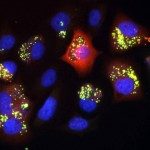Link to Pubmed [PMID] – 15323572
Biochemistry 2004 Aug;43(34):11126-34
The proton-pumping and the ATP hydrolysis activities of the ATP synthase of Rhodobacter capsulatus have been compared as a function of the ADP and P(i) concentrations. The proton pumping was measured either with the transmembrane pH difference probe, 9-amino-6-chloro-2-methoxyacridine, or with the transmembrane electric potential difference probe, bis(3-propyl-5-oxoisoxazol-4-yl)pentamethine oxonol, obtaining consistent results. The comparison indicates that an intrinsic uncoupling of ATP synthase is induced when the concentration of either ligand is decreased. The half-maximal effect was found in the submicromolar range for ADP and at about 70 microM for P(i). It is proposed that a switch from a partially uncoupled state of ATP synthase to the coupled state is induced by the simultaneous binding of ADP and P(i).
